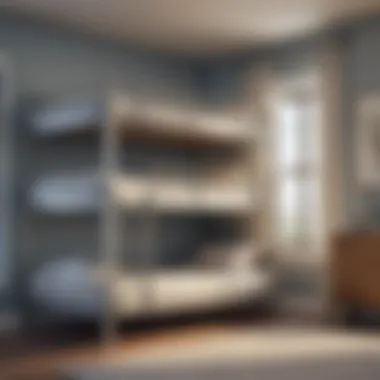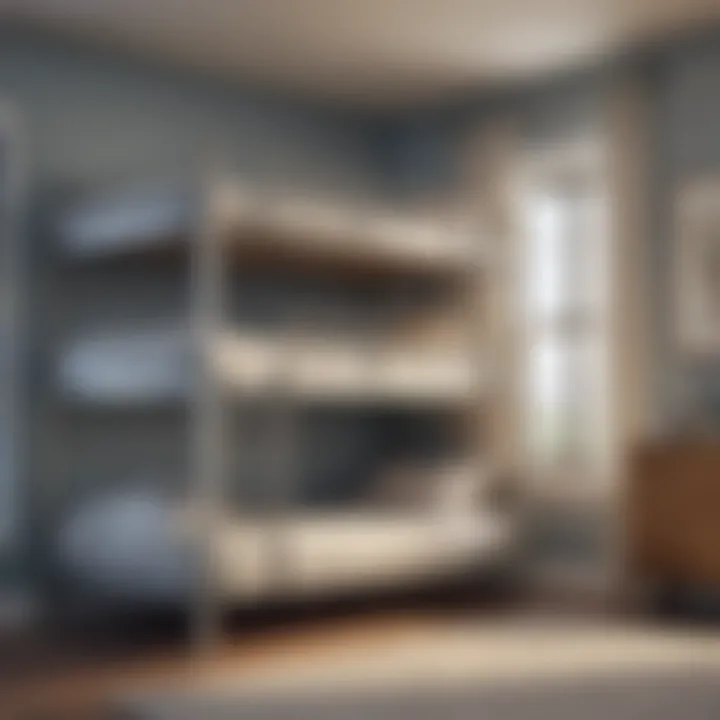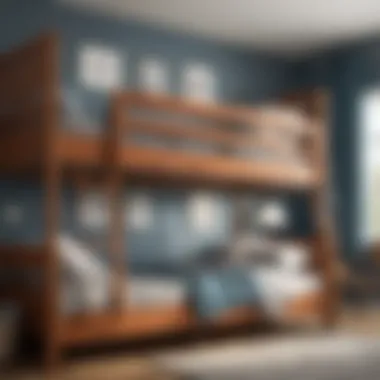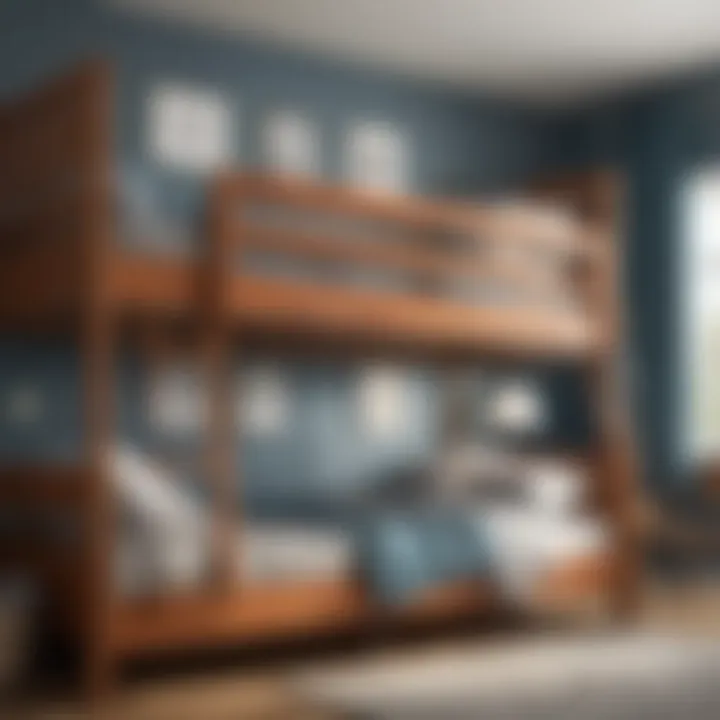Understanding Bunk Bed Width for Optimal Space


Intro
When it comes to maximizing space in a home, bunk beds can be a game changer. Perfect for kids, guest rooms, or even small apartments, these versatile pieces of furniture combine functionality with style. However, understanding the width of a bunk bed is crucial. It’s not merely a number; it influences everything from how easily one can get in and out of bed, to how the room feels overall. With a myriad of styles and configurations on offer, it’s essential to navigate through the options thoughtfully.
This guide aims to dissect the dimensions of bunk beds, particularly focusing on width measurements. It will also touch upon the implications of these measurements on space management and user comfort. Diving deeper, we will explore various styles available in the market, factors that affect width choice, along with recommendations tailored to specific needs. Whether you're a homeowner, a designer, or someone who enjoys the thrill of DIY projects, this guide intends to offer insights that cater to your unique requirements.
Furniture Trends
As tastes in home decor evolve, bunk beds have not been left in the dust. Let's look at some contemporary trends shaping bunk bed designs.
Current Design Trends
Innovative designs have emerged, focusing on much more than just the typical structure. Here are a few notable trends:
- Multi-functional Units: These are bunk beds that come with built-in desks or storage solutions. Ideal for small spaces, they make the most out of every square inch.
- Sleek Minimalism: In an age where less is more, many modern bunk beds sport clean lines and understated aesthetics. This option appeals to those who favor simplicity over ornate designs.
- Customizable Features: More brands are offering customizable options, allowing consumers to choose colors, materials, and sizes that fit their personal style.
Popular Color Palettes
Color can dramatically influence a room’s feel, and with bunk beds, it’s no different. The trend leans towards specific palettes that resonate well with users:
- Natural Wood Tones: Shades of oak, pine, and walnut bring warmth and a touch of nature indoors.
- Vibrant Colors: Some bunk bed models feature bold hues like navy blue or emerald green, giving a fun pop of color especially suited for children’s rooms.
- Neutral Shades: Whites, greys, and beiges remain perennial favorites, offering versatility and ease in blending with various decor styles.
"Choosing the right color and design isn’t just about looks; it’s about creating a harmonious space that enhances everyday life."
Practical Tips
With the right bunk bed, you can optimize both comfort and space. Here are some practical tips to ensure you make the most of that investment.
Furniture Maintenance and Care
To ensure the longevity of your bunk bed, some simple maintenance can go a long way:
- Regular Inspections: Look for loose screws or wear and tear. Tighten any fasteners as needed.
- Cleaning: Dust and wipe surfaces regularly to prevent buildup, especially where safety is concerned.
- Avoid Overloading: Stick to the manufacturer's weight guidelines to avoid compromising bed stability.
Space Utilization Strategies
Optimizing space around your bunk bed can make a world of difference:
- Smart Accessories: Consider adding under-bed storage to keep belongings organized without cluttering the room.
- Zoned Areas: Use the space around the bunk bed efficiently—invest in shelving or a small desk nearby to create distinct zones for different activities.
- Vertical Storage Solutions: Shelves that reach up to the ceiling can maximize space vertically without overwhelming the floor area.
Foreword to Bunk Bed Specifications
When considering the purchase of a bunk bed, understanding its specifications is paramount. This goes beyond just picking a model that looks appealing; it touches on functionality, safety, and comfort. The dimensions of a bunk bed, particularly its width, can influence how well it fits into a space and serves its intended purpose.
Each bunk bed is designed with specific measurements that cater to various needs. For instance, a child's room may require a different width than a guest room, where adults will use it. This thoughtfulness in design can save homeowners from a world of headaches when figuring out how to arrange their space effectively.
Here are some key reasons why diving into bunk bed specifications is crucial:
- Space Efficiency: Knowing the width helps maximize the available room. A well-measured bed leaves space for other furniture, allowing for a more functional area.
- User Comfort: Different people have varying comfort requirements. The width of the bunk bed impacts how cozy it feels. A room that's too cramped can lead to discomfort, especially for taller individuals.
- Safety Standards: Comprehending the specifications can guide buyers towards models that meet safety regulations. Wider beds may offer more stability and support, reducing risks of accidents.
In summary, understanding bunk bed specifications is not just about numbers. It's about making informed decisions that enhance both the aesthetic and practical aspects of a living space while ensuring safety and comfort for all who use it.
Understanding Bunk Bed Width
Bunk bed width holds significant importance in the realm of furniture design and space management. It is more than just a number; it plays a vital role in ensuring user comfort, optimizing your living area, and even promoting safety. With the right measurements, a bunk bed can turn a cramped room into a cozy retreat. On the flip side, incorrect width selections can lead to spatial dysfunction, where one feels boxed in or simply uncomfortable.
Understanding the nuances of bunk bed width can help homeowners and designers alike to make informed choices tailored to specific needs. With styles ranging from basic twin bunk beds to intricate loft designs, width is paramount. It affects how a room feels, how easily one can access the bed, and even how much additional furniture can fit in the space. Therefore, assessing bunk bed width involves not only understanding standard measurements but also taking into account the unique dynamics of a room.
Definition of Width in Context of Bunk Beds


In the context of bunk beds, width refers to the horizontal measurement from one side rail to the other. It provides context for space allocation, ensuring that the bed fits comfortably within the designated area without restricting movement. While the average width varies by model, it is typically crucial to consider how this measurement interacts with other elements in a room.
A key point to keep in mind is that width can also influence how users navigate around the bed. For instance, having too wide a bed in a small space could make it challenging to reach the top bunk or sidestep around the bed without bumping into furniture or walls. Thus, width isn't just a dimension; it's integral to the whole user experience.
Typical Width Measurements
When discussing typical width measurements for bunk beds, variations emerge based on design and size. Here are some common widths to be familiar with:
- Standard Twin Bunk Bed: Generally about 39 inches wide. This dimension works well for smaller rooms and allows for easy bed access.
- Full Bunk Bed: 54 inches wide, providing a more spacious sleep area which might appeal more to older children or adults who use the bottom bunk.
- Twin Over Full Bunk Beds: The width remains generally at 39 inches for the twin section while accommodating 54 inches for the full lower section.
- L-Shaped Bunk Beds: These can vary widely but often have a width similar to two standard twin beds side by side, creating a more room-like structure.
In summary, understanding the range of bunk bed widths is crucial for making decisions that enhance both comfort and utility. The impact of width extends beyond mere numbers; it shapes the entire experience of living and sleeping in a shared or limited space.
Factors Influencing Bunk Bed Width
Understanding the factors that influence bunk bed width is crucial for anyone in the market for these multi-functional sleeping solutions. The width of a bunk bed can have a significant impact not just on how it fits into a particular space but also on the overall usability and comfort for its occupants. Let’s delve into various aspects that affect width, including room size, user age, and design preferences.
Room Size and Layout Considerations
When selecting a bunk bed, the first thing to consider has to be the space you’re working with. The dimensions of your room will guide what kind of width you can accommodate. A narrow room requires a more compact bed design to ensure there’s still space for movement.
- Measure Twice, Cut Once: A common adage that applies here as well. Before you purchase, it’s pivotal to only go in with accurate measurements. Most standard bunk beds will fall between 36 to 42 inches width, but it can vary broadly based on the style and design.
- Layout Options: The placement of the bunk bed also holds importance. If the room has other elements—like wardrobes or dressers—these must harmonize with the width of the bed, ensuring access and comfort. Kids might need space to move around safely, not just their sleeping quarters.
User Age and Comfort Requirements
The age of the user directly affects what width will be suitable. For instance, a bunk bed meant for toddlers might benefit from a narrower design to fit tighter spaces and provide a cozy sleeping environment. On the flip side, teens or adults might need a more spacious setup.
- Child-Friendly Designs: When choosing for younger users, consider wider bunk beds which allow sufficient space to prevent tumbles during sleep. That extra room can be a real lifesaver.
- Teen Versatility: For teenagers, a fuller width may be desired, particularly if they expect to host friends or value comfort during sleep. A twin-over-full setup, for instance, can accommodate sleepovers while still allowing room to spread out.
Design Styles and Aesthetic Preferences
How a bunk bed looks might play a surprising role in determining its width. Design choices can range from minimalist styles that maximize space to elaborately crafted wooden versions that take a more substantial footprint.
- Minimalist Appeal: A simple, slimline design could be around 35 inches in width, offering a sleek look without overwhelming the room. This type fits well in smaller areas, or even in kids' bedrooms allocated for multiple purposes.
- Rustic and Chunky Designs: If one tends to lean more towards the rustic or vintage styles, it could entail wider dimensions—often exceeding 40 inches. This adds a rugged charm but takes up more room.
As a general note, the blend of width with aesthetic appeal must be balanced against practical considerations. Aesthetic decisions should complement everyday usability and the natural passage through your space. It’s this interplay between width and design that can make or break how functional the bunk bed will be for you.
It’s wise to look beyond mere aesthetics and measurements—always ask yourself, how will this impact the day-to-day life in your home?
Comparative Analysis of Bunk Bed Designs
Examining bunk bed designs is crucial in making informed decisions that cater to various spatial and functional needs. This comparative analysis provides insights into the strengths and weaknesses of different styles, giving homeowners, designers, DIYers, and agents tools to select the most suitable option. Each design offers unique benefits and considerations that align with different lifestyle requirements, making this section particularly relevant to optimizing space while ensuring comfort and safety.
Standard Bunk Beds
Standard bunk beds are perhaps the most recognizable style. They typically feature two beds stacked vertically, sharing the same width. This design maximizes floor space, making it ideal for smaller rooms where every inch counts. A uniform width across the beds allows for straightforward mattress selection, typically accommodating twin-size mattresses.
However, there are a few factors to consider. For instance:
- Height Constraints: Depending on a room's ceiling height, a standard bunk bed may result in insufficient headroom, limiting comfort.
- Weight Distribution: The design can affect weight distribution; thus, construction quality is vital for safety.
While these beds are practical for kids or guest rooms, they might not be the best choice for adults due to comfort and accessibility concerns.
Twin Over Full Bunk Beds
Twin over full bunk beds are another popular design. As the name suggests, this setup consists of a twin bed on top and a full bed on the bottom. This configuration is particularly suitable for siblings or sleepovers, allowing for ample sleeping space without sacrificing too much width.
Advantages of this design include:
- Comfort for Older Children: The fuller sleeping area at the bottom caters to growing kids and teens.
- Versatility: The bottom full bed allows the possibility of being used by an adult, making it versatile over the years.
However, they do require careful layout planning, as the wider bottom bunk takes up more space. Additionally, security features like guard rails and proper ladder designs become even more critical for safety.


L-Shaped Bunk Beds
L-shaped bunk beds offer a modern twist on traditional designs. Comprising two beds arranged in an ‘L’ formation, this style provides distinctive advantages. One of its greatest strengths lies in its ability to maximize floor space in an entirely different way compared to standard models.
Some benefits include:
- Additional Functional Space: The area beneath the upper bed can often be utilized for a desk or play area, making it incredibly functional.
- Variety of Configurations: These beds can be placed in corners or along walls, providing flexibility in various room layouts.
Nevertheless, it's essential to assess the room's layout carefully, as the unique shape may not fit all spaces. This design tends to have a larger footprint, and understanding precise width dimensions becomes key in making the right choice.
Loft Beds: An Alternative
Loft beds stand out by offering an elevated sleeping area with an open floor space below, which can be customized for various uses. While they may not fit everyone, they serve as a great alternative for those seeking to save floor space without the need for a bottom bunk.
Key highlights of loft beds include:
- Maximized Usable Space: The space underneath can be transformed into a study nook, storage, or even a small play area.
- Variety of Styles: Available in various styles and materials, loft beds cater to different aesthetic preferences while remaining compact in width.
However, the height might pose security concerns. Ensuring adequate safety measures, like guard rails, is essential to mitigate risks associated with falling.
The comparative analysis of these bunk bed designs not only aids in visualizing how they will fit into those tight quarters but also factors in user experience and safety. Each choice holds potential dilemmas and delights that merit careful consideration.
Materials and Their Impact on Width
When selecting a bunk bed, an often overlooked aspect is the materials used in its construction. The material choice not only shapes the bed's structural integrity but also influences its width, comfort, and safety features. Understanding how different materials can impact these factors is crucial for making an informed decision that aligns with your needs and style preferences.
Wood vs. Metal Construction
Wood and metal are the leading contenders in the bunk bed material race, each boasting distinct benefits. From aesthetic appeal to durability, here’s a closer look:
- Wood: The warmth of natural wood often brings a cozy feel to a room. Its inherent sturdiness allows for wider designs without compromising safety. However, wooden bunk beds can be bulky, and their width can vary significantly based on the wood type used. A solid oak construction is usually thicker and can offer more stability but might feel larger due to its heft. Alternatively, lightweight woods like pine can result in narrower designs, making them more suitable for tighter spaces. The grain and finish also play a role, with knots and textures affecting the overall width perception.
- Metal: On the flip side, metal beds tend to have a sleeker profile and can lend a modern touch to decor. They generally allow for innovative designs with adjustable width features. Metal frames can be narrower while maintaining strength, aiding in optimal space utilization, particularly in smaller rooms. They are also easier to maneuver, often allowing for quicker setups. However, some designs might compromise comfort due to the rigidity of metal.
Ultimately, the choice between wood and metal boils down to personal preference, intended use, and design needs.
Weight Capacity and Its Relation to Dimensions
When discussing width, another crucial element is the weight capacity, directly influenced by the materials selected. The weight limit of a bunk bed can determine its overall dimensions, including width. Wider beds can typically accommodate more weight due to their expansive support systems gained from frame construction.
- Heavy Duty Designs: If you're considering heavier users, opting for a wider, more robust design can enhance stability. For instance, a heavy-duty steel frame would provide a higher weight capacity, allowing for a wider sleeping area without sacrificing safety. Wider bunks can also offer more space for movement, which is beneficial for users who may toss and turn at night.
- Weight Distribution: The materials also affect weight distribution. A wooden frame may provide a distributed weight capability due to the natural elasticity of wood, which is less prone to creaking or buckling under pressure. Conversely, metal frames might handle concentrated weight better, allowing for a thinner design but ensuring all contact points are secure.
It's clear that the intersection of materials, weight capacity, and width creates a complex relationship that influences your final choice. Careful consideration of these elements ensures not only a functional solution to space constraints but also a long-lasting and comfortable sleeping arrangement.
Choosing the right material affects not just comfort and style, but also how the bunk bed performs under weight.
In summary, whether it's the warmth and tradition of wood or the modern edge of metal, understanding materials and their impact on width is essential for anyone looking to buy a bunk bed. It allows you to ensure your selection fits seamlessly into your home while providing the necessary support and aesthetics.
Safety Standards and Regulations
When considering bunk beds, prioritizing safety standards and regulations is essential. These guidelines not only address potential hazards but also play a critical role in ensuring that these sleep systems meet the needs of their users. Here are a few reasons why safety standards can't be overlooked:
- User Protection: Regulations are designed to protect users, particularly children who are most susceptible to accidents. A well-regulated bunk bed can significantly reduce the risks of falls or injuries.
- Quality Assurance: Compliance with safety standards often means that the materials and construction have been thoroughly tested for durability and reliability. This factor plays a vital role in long-term use and overall satisfaction.
- Peace of Mind: Knowing that a bunk bed has met safety regulations can provide peace of mind for homeowners, parents, and others who may be responsible for occupants' safety.
To navigate the maze of these standards, understanding safety ratings is the first step.
Understanding Safety Ratings
When it comes to bunk beds, safety ratings can serve as a beacon of hope for those wanting reassurance about their purchase. Ratings often come from independent testing organizations that scrutinize various aspects of the design and construction. Here’s what you need to know:
- ASTM International: This organization sets forth stringent standards for bunk bed safety. Products that pass their tests will usually display the ASTM seal, indicating compliance with rigorous measurement criteria.
- Consumer Product Safety Commission (CPSC): The CPSC provides federal safety regulations for bunk beds. Their guidelines cover everything from mattress size to guardrail requirements, ensuring that beds are secure and free from design flaws that could lead to injury.
- Weight Capacity Ratings: These ratings ensure that a bunk bed can hold the intended load without compromising safety. Manufacturers should be transparent about their weight limits, as it's crucial for both users’ safety and product longevity.
A bunk bed that meets all safety standards can offer not just reliability but also confidence to users and parents alike, knowing they have made a smart choice.


Importance of Width in Safety Design
Width is an often overlooked but significant element in ensuring bunk bed safety. The design’s width can affect the overall stability and user experience. Here’s why width should be on your radar:
- Stability: A wider base generally provides more stability, reducing the risk of tipping over when users climb in or out of bed. This is especially crucial for top bunks where the risk of falls is prevalent.
- Guardrail Effectiveness: Guardrails are essential for preventing falls. A sufficient width allows for more effective guardrail design, keeping occupants securely within their space.
- Ease of Movement: A bunk bed that isn't too narrow allows users to maneuver more easily, whether that's getting in or out, or when changing bedding. This ease of movement contributes to the user’s overall sense of safety and comfort.
In summary, the width of a bunk bed isn't just about fitting it into your room; it plays a vital part in its safety design, affecting how secure and comfortable the bed will feel for its users.
Practical Considerations When Choosing a Bunk Bed
When it comes to selecting a bunk bed, there are many factors to take into account. It's not just about picking something that looks nice or fits in your space. Having a clear perspective on practical considerations is crucial for ensuring the bed meets both functional and aesthetic needs. This section dives into two vital elements: assessing space requirements and evaluating user experience and accessibility.
Assessing Space Requirements
Before making a decision that you might regret later, assessing space requirements is crucial. Bunk beds can be space-saving solutions for those tight on square footage, but this doesn’t mean you can ignore the dimensions. Here are some aspects to consider:
- Room Size: Measure your room meticulously. You might have a 12-foot by 10-foot space, but having an exact figure helps in making informed choices. A bunk bed might fit, but you'll want space around it so you’re not playing a game of Tetris every time you walk into the room.
- Ceiling Height: Many overlook the importance of vertical space. Bunk beds can rise quite high, and you definitely don’t want to create a claustrophobic experience or risk hitting the top when sitting up. A good rule is to have at least 30 inches of clearance between the top bunk and the ceiling.
- Location Within the Room: Consider the layout of furniture. If your bunk bed blocks windows or restricts movement, it may end up making the room feel smaller than it actually is.
"Space might seem fixed at first glance, but the right furniture arrangement can change everything."
- Additional Furniture: Think about what else needs to go in that space. Desks, dressers, or shelves add to the equation. If they’re crammed together, the room won't just look cluttered but could also feel chaotic.
Taking these measurements will not only help in fitting the bed perfectly into the room but will also enhance the overall aesthetic and functional feel of the space.
Evaluating User Experience and Accessibility
User experience with a bunk bed extends beyond merely climbing up and down. It's about the comfort and ease with which the bed can be used. Here’s what to keep in mind:
- Age of Users: The age of individuals using the bunk bed greatly affects accessibility. Younger kids might struggle with adult-style ladders or stairs. On the flip side, older teens or adults may prefer sturdier, more spacious designs which could limit certain models.
- Ease of Access: Examine ladder styles. Some designs utilize attached ladders, while others might have detachable options. A dedicated stairway often provides additional safety but can take more room.
- Weight Limit Considerations: It’s not just about fitting a mattress on the bunk bed; check the weight limits too. If it’s a shared space or if you have older kids, the weight capacity might dictate whether certain beds will work or not.
- Usability of Lower Bunk: Some family setups prefer a shorter bed beneath, suitable for children or guests. Think about who will sleep there—will they be comfortable? Is there enough room to sit up without feeling cramped?
Addressing these aspects will not only ensure that the bunk bed satisfies practical needs but also contributes significantly to the happiness of the users. Choosing with care pays off.
With all this in mind, homeowners, designers, and DIYers will find themselves better equipped to make a sound choice that aligns with their needs.
Frequently Asked Questions about Bunk Bed Width
When it comes to choosing the right bunk bed for your home, understanding the width is crucial. This section sheds light on some common questions that people often have regarding bunk bed width. These questions not only help clarify doubts but also assist in making informed decisions when selecting a bunk bed. It's about finding the right balance between comfort, safety, and the size of the space it will occupy.
Common Misconceptions
A lot of myths float around when discussing bunk bed choices, especially regarding width. For instance, many believe that all bunk beds come in standard widths, but that's not entirely true. Width can vary based on design and style. Many folks think that a wider bunk bed means better comfort. However, it can be the case that a narrow bed can be equally comfortable, if it’s designed well. Understanding that width options can differ—like the distinction between a twin and a full bunk bed—helps avoid confusion.
Some people also fear that wider beds might take up too much room in a child's room, making it comforting to know that with modern designs, everything is usually more space-efficient than it appears. Bunk beds today can be quite sleek and compact, making them suitable for various room sizes. Being mindful of these misconceptions can greatly aid in making an educated decision that aligns with your needs and space.
Tips for Maintaining the Ideal Width
Maintaining the ideal width for a bunk bed involves careful consideration of multiple factors. Here are some pointers:
- Room Measurement: Always measure your room before making a purchase. Ensure to include any additional space required for making the beds and safety clearance around them.
- User Needs: Consider who will be using the bunk bed. If it's for a child, the practicality of getting in and out safely is key. An adult might prefer something that feels spacious.
- Bed Accessories: Think about bedding or mattress thickness as it can impact the perceived width of the bed. A thicker mattress might mean the need for a wider frame.
- Adjustable Options: Some bunk beds come with adjustable widths or configurations. If in doubt, look for models that offer flexibility in design.
"Choosing wisely ensures that a bunk bed not only fits well but feels good too, not crammed or restrictive."
- Regular Maintenance: Ensure the bed stays in top shape—regularly checking for any wobbling or wear can make a world of difference in comfort and safety.
- Reassess: Once in use, always reassess your space. It might be worthwhile to adjust how the bunk bed is positioned to create a more open feel.
By keeping these aspects in mind, you can create not just a sleeping space but a comfortable nook that feels right for everyone who uses it.
Culmination
In wrapping up this journey through the intricacies of bunk bed width, it becomes crystal clear how essential this topic is for anyone diving into the world of multi-tiered sleeping arrangements. Not only does width play a pivotal role in determining how a bunk bed fits into a room, but it also influences comfort, safety, and even the visual appeal of the space.
By considering the various designs available, from standard models to L-shaped configurations, you can make informed decisions that align with both space availability and user requirements. The importance of width extends beyond mere measurements; it encompasses factors such as user age, intended usage, and personal aesthetics. When you select a bunk bed that fits snugly into your room's dimensions while also providing ample comfort, you are effectively maximizing your living area without compromising on style or functionality.
"The right bunk bed width isn't just about fitting a mattress; it's about enhancing the quality of life in small spaces."
Safety can’t be overlooked either. A bed that’s too narrow might lead to imbalance, while one that’s excessively wide could dominate the room. Adhering to recommended safety standards ensures that you are not only choosing a bed that looks good but also one that prioritizes the well-being of its users.
Ultimately, this guide has sifted through essential considerations to prepare you for selecting a bunk bed tailored to your needs. From understanding the specifics of width and its impact on comfort to evaluating various models, every element plays a crucial role in your choice. Whether you're a homeowner wanting to optimize space or a designer seeking functional aesthetic solutions, keeping these factors in mind can lead to satisfactory outcomes that leave both you and those using the bunk bed content and comfortable in their shared space.















